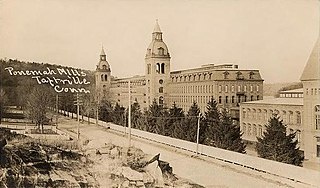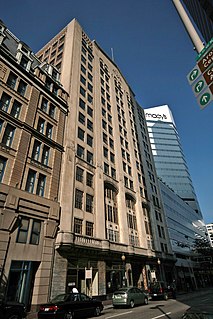
Seneca is a city in Oconee County, South Carolina, United States. The population was 8,102 at the 2010 census. It is the principal city of the Seneca Micropolitan Statistical Area, an (MSA) that includes all of Oconee County, and that is included within the greater Greenville-Spartanburg-Anderson, South Carolina Combined Statistical Area. Seneca was named for the nearby Cherokee town of Isunigu, which English colonists knew as "Seneca Town".

Lyman is a town in Spartanburg County, South Carolina, United States. The population of Lyman was 3,243 at the 2010 census.

Chesnee is a city in Spartanburg and Cherokee counties, in the U.S. state of South Carolina. The population was 868 as of the 2010 census.

Taftville is a small village in eastern Connecticut. It is a neighborhood of Norwich but has its own post office. It was established in 1866 as site for the large Taftville Mill, later Ponemah Mill. The village is listed on the National Register of Historic Places as Taftville and as alternative name Taftville/Ponemah Mill National Register Historic District.

Converse College is a private university in Spartanburg, South Carolina. It consists of an undergraduate coeducational college as well as coeducational graduate, online, and summer programs. It was established in 1889 by a group of Spartanburg residents and named after textile pioneer Dexter Edgar Converse.

Harmony Mills, in Cohoes, New York, United States, is an industrial district that is bordered by the Mohawk River and the tracks of the former Troy and Schenectady Railroad. It was listed as Harmony Mills Historic District on the National Register of Historic Places in 1978. A portion of the district encompassing the industrial buildings and some of the housing built for millworkers was declared a National Historic Landmark in 1999. The centerpiece building, Harmony Mill No. 3 was listed on the National Register of Historic Places in 1971.

Musgrove Mill State Historic Site was the site of the Battle of Musgrove Mill, an action in the American Revolutionary War, which occurred on August 19, 1780, near the Enoree River, on what is the border between Spartanburg, Laurens, and Union Counties in South Carolina, approximately seven miles from Interstate 26.

Anderson Downtown Historic District in Anderson, South Carolina originally built in the late 19th century is a historic district that was listed on the National Register of Historic Places in 1979.

Lockwood, Greene & Co. was an American architectural firm. Their work was part of the architecture event in the art competition at the 1928 Summer Olympics.

The Highland Park Manufacturing Company Mill No. 3 is a historic textile mill complex and national historic district located at 2901 N. Davidson St. in Charlotte, Mecklenburg County, North Carolina. The district encompasses included five contributing buildings and are the original mill building (1903-1904) and major weaving room addition, Gate House, Dye House, Boiler House, and Waste House (1903-1904). The original mill was designed by Stuart W. Cramer and features a four-story tower capped by fancy corbelling and crenelated parapets.

Mills Mill was a textile mill in Greenville, South Carolina (1897-1978) that in the 21st century was converted into loft-style condominia. The building is listed on the National Register of Historic Places.

Monaghan Mill, now the Lofts of Greenville, is a former textile mill (1900–2001) in Greenville, South Carolina, that in the early 21st century was converted into loft apartments. The building is listed on the National Register of Historic Places.

Pacolet Mills Historic District is a national historic district located at Pacolet, Spartanburg County, South Carolina. It encompasses 126 contributing buildings and 1 contributing site in the mill village of Pacolet. Pacolet Mills village that was laid out and built in 1919, with most worker and supervisor houses were built between 1915 and 1920. Also located in the district are the Pacolet Mills Cloth Room and Warehouse, Pacolet Mill Office, and two churches. The three main Pacolet Mills and a fourth mill (1894) were demolished in the late 1980s.

Cleveland Law Range is a historic office building located at Spartanburg, Spartanburg County, South Carolina. It was built in 1898–1899, and is a three-story, Richardsonian Romanesque style brick building. It features five arched bays on the ground floor, with repeated bay arrangements on the second and third floors. Three South Carolina governors maintained offices in the Cleveland Law Range: James F. Byrnes, John Gary Evans, and Donald S. Russell.

The Montgomery Building, listed on the National Register of Historic Places, is an iconic building located on Church Street in Spartanburg, Spartanburg County, South Carolina. It was built in 1924, and is a ten-story, nine-bay-wide, steel frame skyscraper faced in precast concrete. It originally housed the offices of textile companies, cotton brokers, and factories. The building also contained a theatre/auditorium space, a radio and television station. The Montgomery Building was the tallest building in Spartanburg until the 1950s. In 2016, a developer announced that they planned to renovate the building for mixed-use to include apartments, offices and retail. Restoration began in Spring 2017 and was completed in December 2018.

Drayton Mill is a historic textile mill complex located near Spartanburg, Spartanburg County, South Carolina. The complex includes the distinctive Tudor Revival company store and office building, constructed in 1919. Other buildings and structures include the three-story, rectangular, red brick spinning mill (1902-1904) with later additions, a cotton warehouse (1918), a two-story weaving building (1928), a 1,500,000 gallon mill pond, two water towers, two pump buildings, and an information center.

Brandon Mill, now the West Village Lofts, is a historic textile mill complex, situated just west of the city of Greenville, Greenville County, South Carolina. The mill was built during the early decades of the 20th century and is one example of the mills in the Greenville "Textile Crescent" that became central to the economic development of the South Carolina upstate during this period. The complex was listed on the National Register of Historic Places in 2014, and the main mill has been converted into loft apartments.

Arcadia Mills No. 1, now the Arcadia Station Lofts, is a historic mill building at 1875 Hayne Street in Spartanburg, South Carolina. The mill was built in 1903 and enlarged in 1909, to designs by Greenville J.E. Sirrine. It is a well-preserved example of textile mill engineering from the early years of South Carolina's boom period in that industry.

The Apalache Mill, now the Lofts by the Lake, is a historic textile mill at 2200 Racing Road in Apalache, South Carolina. The main mill building, a three-story brick building with plain late-19th century styling, sits at the southern end of Apalachee Lake, created by damming the Tyger River at a narrow gorge just to the east. Built in 1888, it is one of the first mills to be built in the Spartanburg area, and remained in active service until 2007.

The Inman Mills, now the Lofts at Inman Mills, are a historic textile mill complex at 240 4th Street in Inman, South Carolina. The mill complex includes a large main mill building and a number of smaller buildings, some attached, as well as a smokestack. The main building is a large rectangular four-story brick building with largely bricked-over segmented-arch window bays, and a five-story central tower. The mill was built in 1902 for the Chapman family, and was designed by the prominent regional mill architect W.B. Smith Whately. The mill was closed in 2001, and was for many years one of the city's major employers.























